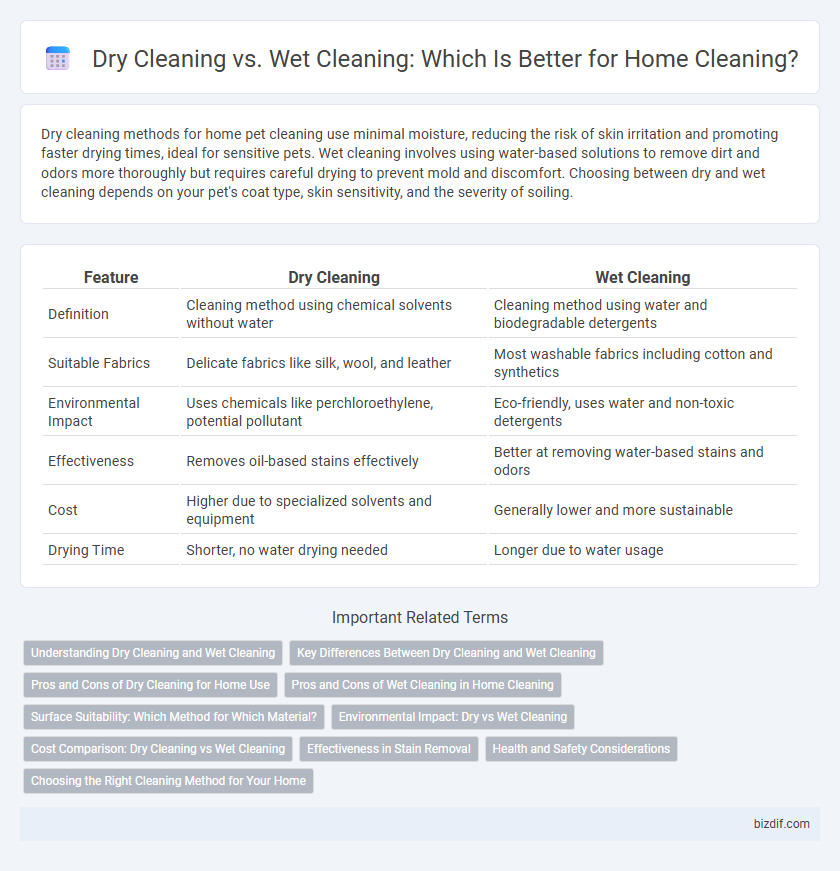Dry cleaning methods for home pet cleaning use minimal moisture, reducing the risk of skin irritation and promoting faster drying times, ideal for sensitive pets. Wet cleaning involves using water-based solutions to remove dirt and odors more thoroughly but requires careful drying to prevent mold and discomfort. Choosing between dry and wet cleaning depends on your pet's coat type, skin sensitivity, and the severity of soiling.
Table of Comparison
| Feature | Dry Cleaning | Wet Cleaning |
|---|---|---|
| Definition | Cleaning method using chemical solvents without water | Cleaning method using water and biodegradable detergents |
| Suitable Fabrics | Delicate fabrics like silk, wool, and leather | Most washable fabrics including cotton and synthetics |
| Environmental Impact | Uses chemicals like perchloroethylene, potential pollutant | Eco-friendly, uses water and non-toxic detergents |
| Effectiveness | Removes oil-based stains effectively | Better at removing water-based stains and odors |
| Cost | Higher due to specialized solvents and equipment | Generally lower and more sustainable |
| Drying Time | Shorter, no water drying needed | Longer due to water usage |
Understanding Dry Cleaning and Wet Cleaning
Dry cleaning uses chemical solvents, primarily perchloroethylene, to remove stains and dirt from delicate fabrics without water, preserving fabric texture and color. Wet cleaning employs water and specialized detergents with controlled mechanical action to clean garments safely, suitable for materials labeled as water-safe. Understanding the differences helps in choosing the appropriate method for fabric care, ensuring garment longevity and effective stain removal.
Key Differences Between Dry Cleaning and Wet Cleaning
Dry cleaning uses chemical solvents like perchloroethylene to clean delicate fabrics without water, preventing shrinkage and distortion. Wet cleaning employs water and specialized detergents with controlled mechanical action, making it ideal for eco-friendly and sensitive textile care. Key differences include solvent usage, fabric compatibility, environmental impact, and the type of stains effectively removed.
Pros and Cons of Dry Cleaning for Home Use
Dry cleaning offers effective stain removal for delicate fabrics without water, reducing the risk of shrinkage and color fading in home-use garments. It uses chemical solvents like perchloroethylene, which can be harmful if not handled properly, posing ventilation and health concerns in residential settings. While dry cleaning excels at preserving fabric integrity, the need for specialized equipment and potential environmental impact limits its practicality for typical home cleaning tasks.
Pros and Cons of Wet Cleaning in Home Cleaning
Wet cleaning in home cleaning uses water and biodegradable detergents, making it environmentally friendly and effective for removing organic stains. It is gentle on delicate fabrics and reduces the risk of chemical residues, but it may cause shrinking, color bleeding, or damage to sensitive materials. Despite these risks, wet cleaning offers a safe alternative to traditional dry cleaning solvents, promoting healthier indoor air quality and sustainability.
Surface Suitability: Which Method for Which Material?
Dry cleaning excels in treating delicate fabrics like silk, wool, and leather without causing shrinkage or color fading, making it ideal for upholstery and garments sensitive to water damage. Wet cleaning is highly effective on sturdier surfaces such as cotton, linen, and synthetic fibers, offering thorough stain removal and freshness while preserving fabric integrity. Choosing the appropriate method depends on the surface material, where dry cleaning protects moisture-sensitive items and wet cleaning maintains cleanliness in durable textiles and most household surfaces.
Environmental Impact: Dry vs Wet Cleaning
Dry cleaning uses chemical solvents like perchloroethylene, which can persist in the environment and pose health risks if not managed properly. Wet cleaning relies on water and biodegradable detergents, resulting in lower toxic emissions and reduced environmental impact. Choosing wet cleaning supports sustainable practices by minimizing pollution and conserving water resources.
Cost Comparison: Dry Cleaning vs Wet Cleaning
Dry cleaning typically costs between $10 and $25 per garment, depending on fabric type and service location, while wet cleaning generally ranges from $5 to $15 per item. The higher price of dry cleaning reflects the specialized solvents and chemical processes used to protect delicate materials, whereas wet cleaning employs environmentally friendly water-based techniques that reduce operational costs. Choosing between these methods depends on budget constraints and fabric care requirements, with wet cleaning offering a more economical and eco-conscious option.
Effectiveness in Stain Removal
Dry cleaning effectively removes oil-based stains and delicate fabric soils without water, preserving garment integrity and preventing shrinkage. Wet cleaning excels at eliminating water-based stains and heavy soils through controlled moisture and specialized detergents, providing a thorough cleanse. Selecting between these methods depends on stain type and fabric sensitivity, optimizing stain removal while maintaining fabric quality.
Health and Safety Considerations
Dry cleaning uses chemical solvents like perchloroethylene, which can pose health risks such as respiratory irritation and long-term exposure concerns, requiring proper ventilation and protective equipment. Wet cleaning employs water and biodegradable detergents, minimizing chemical exposure and reducing environmental hazards, making it safer for sensitive skin and respiratory conditions. Choosing wet cleaning methods enhances health and safety by avoiding toxic chemicals while still effectively removing stains and dirt from fabrics.
Choosing the Right Cleaning Method for Your Home
Dry cleaning effectively removes stains from delicate fabrics like silk and wool without water, preserving their texture and color. Wet cleaning is ideal for heavily soiled items and durable materials, using water and specialized detergents to achieve deep cleaning. Selecting the right method depends on fabric type, stain severity, and environmental sensitivity to maintain your home's textile integrity and cleanliness.
Dry Cleaning vs Wet Cleaning Infographic

 bizdif.com
bizdif.com